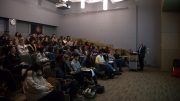Last Wednesday, the native studies’ 2014 winter colloquium featured Christy Anderson, a master’s student researching the marginalization of Aboriginal women in Canadian society.
Her presentation was timely given the recent murder of Loretta Saunders that once again brought the issue of the disproportionately large number of missing and murdered Aboriginal women to the attention of Canadians.
Saunders, a 26-year-old Inuk woman, went missing on Feb. 13. At the time, she was studying the issue of missing and murdered women at St. Mary’s University in Halifax. Her body was found Feb. 26 and her two roommates have been charged with first-degree murder.
Saunders’ funeral was held on Mar. 8, amidst Nova Scotia’s three political parties calling for a “national public inquiry” into missing and murdered Aboriginal women.
Anderson argued that the marginalization and victimization of indigenous women like Loretta Saunders can be explained by the structural and cultural violence that is endemic in Canadian society.
Anderson said that structural violence is the “avoidable disparity between the ability to fulfill a person’s basic needs and their actual fulfillment.”
Structural violence provides an explanation for the social marginalization of individuals in society, according to Anderson. It is invisible, she explained, but built into the system, resulting in unequal power and life chances.
Anderson introduced the concept of cultural violence, and argued that it explains why structural violence is racialized. Cultural violence attributes a particular culture’s values, beliefs, and low social status as being inconsistent with the dominant culture in society. It blames the culture of a marginalized group for that marginalization instead of looking at the system, she explained.
“Colonialism, capitalism, and patriarchy are predicated on violence, and the impact of these structures on Aboriginal women’s well-being has been devastating [ . . . ] leaving them the most vulnerable sector of our society,” said Anderson.
This vulnerability is demonstrated in statistics that show Aboriginal women are more likely to live in poverty, to be unemployed or in low-paying jobs, to be the head of lone-parent households, and, most tragically, to be subjected to high rates of violence.
Anderson said that recent policy changes that are supposed to address these inequalities, such as Bill C-31, have only masked the continuation of racist and sexist legislation.
Anderson further argued that a number of reports have come out—such as the Royal Commission on Aboriginal Peoples, and Amnesty International’s Stolen Sisters report—that identify the structural problems and offer potential solutions, but that “there is a lack of political will to act on these reports and fix what is broken.”
Recently there have been many conversations about the marginalization and victimization of Aboriginal women on Facebook and Twitter with the hashtag #ItEndsHere.
Leanne Simpson—an Anishinaabe activist, writer, and academic—posted in the Indigenous Nationhood Movement’s blog, Voices Rising, on Mar. 5. Her entry titled “Not Murdered and Not Missing: Rebelling Against Colonial Gender Violence” bore the #ItEndsHere hashtag.
Simpson’s post expressed her lack of confidence in the ability of the Canadian government to undertake an inquiry that will bring about any real change or address the concerns raised by Aboriginal people.
Simpson points the finger at Canada as the perpetrator and beneficiary of gender violence. She wrote, as she is “not murdered and not missing,” she will continue the work Saunders started and will “[fight] for indigenous nations and a relationship with Canada that is no longer based on violence, heteropatriarchy, and silence.”




